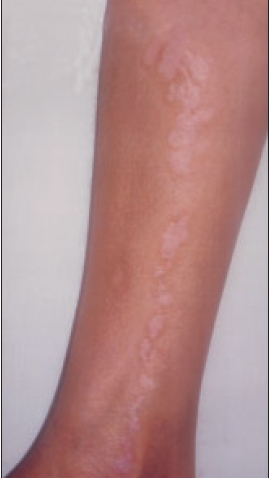Translate this page into:
Linear psoriasis
Correspondence Address:
Sanjay Kanodia
C-90, Sethi Colony, Jaipur - 302 004
India
| How to cite this article: Purohit S, Kanodia S, Shukla S R, Saxena V N, Meena R S, Saxena V. Linear psoriasis. Indian J Dermatol Venereol Leprol 2006;72:398 |
 |
| Psoriatic plaques in linear distribution |
 |
| Psoriatic plaques in linear distribution |
Sir,
A 12-year-old boy born of nonconsanguineous marriage presented to the Skin OPD with complaints of linear erythematous, scaly lesions over the medial side of right leg extending from the medial malleolus to just below the right knee. Initially, four years ago, erythematous scaly plaques appeared over the medial malleolus. For two years the lesions were static, a few in number and small in size, approximately 1 x 2 inches. But in the last two years, the plaques increased in number and size and gradually spread upwards towards the knee joint. The lesions were asymptomatic. Cutaneous examination showed well-defined, erythematous scaly plaque, 15-20 in number, arranged in a linear pattern varying from 1 to 3 inches in size and at places coalescing to form larger plaques and extending from the medial malleolus to right knee joint [Figure - 1]. There was no nail involvement. There was no history of similar lesion in other family members.
Blood counts and biochemistry were normal. Initially, the condition was diagnosed as nevoid psoriasis because of the persistence of the lesions continuously for four years, which appeared at the age of eight years and extended along the lines of Blaschko. Skin biopsy was taken and the patient was prescribed moderate potency steroid to be applied topically twice daily for two weeks. To our surprise on the next visit after three weeks, the lesions had almost cleared. The H and E stained section showed histological features of psoriasis. Hence the diagnosis of psoriasis was made.
Psoriasis is a common genetically determined disease with atypical forms such as linear, zonal, regional, verrucous, follicular, lichenoid and seborrheic psoriasis.
Linear psoriasis may develop in the presence of other typical lesions as a part of Koebner′s phenomenon. However, true linear psoriasis in the absence of lesions elsewhere is extremely rare[1] and it may be confused with inflammatory epidermal nevus or Koebner′s response of psoriasis on verrucous epidermal nevus.[2] The lesions were clinically and histologically similar to psoriasis vulgaris. Dermatitic epidermal nevi have also been reported to be invaded by psoriasis as a result of Koebner′s phenomenon[3] but the lesions are intensely pruritic. Also, in the majority of cases, more typical psoriatic lesions appear later on other sites of the body. This reported case did not develop psoriatic lesions elsewhere during the span of four years; the lesions were asymptomatic with no inflammatory reaction and the histopathology showed features purely of psoriasis.
In linear psoriasis and naevoid psoriasis, lesions are clinically and histologically similar in appearance but the former is present as linear configuration, the latter is distributed in specific band-like zones of the skin (the lines of Baschko).[4] The reason for this could be that linear psoriasis develops as a part of an isomorphic phenomenon, while in naevoid psoriasis, mosaicism is responsible for the same genetic predisposition that is universally present in the skin of ordinary psoriasis.[5]
| 1. |
Goujon C, Pierini AM, Thivolet J. Does linear psoriasis exist? (author's transl). Ann Dermatol Venereol 1981;108:643-50.
[Google Scholar]
|
| 2. |
Morag C, Metzker A. Inflammatory linear verrucous epidermal naevus: Report of seven new cases and review of the literature. Pediat Dermatol 1985;15-8.
[Google Scholar]
|
| 3. |
Bondi EE. Psoriasis overlying an epidermal naevus. Arch Dermatol 1979;115:624-5.
[Google Scholar]
|
| 4. |
Bolognia JL, Orlow SJ, Glick SA. Lines of Blaschko. J Am Acad Dermatol 1994;31:157-90.
[Google Scholar]
|
| 5. |
Atherton DJ, Kahana M, Russell-Jones R. Naevoid psoriasis. Br J Dermatol 1989;120:837-41.
[Google Scholar]
|
Fulltext Views
4,177
PDF downloads
2,503





